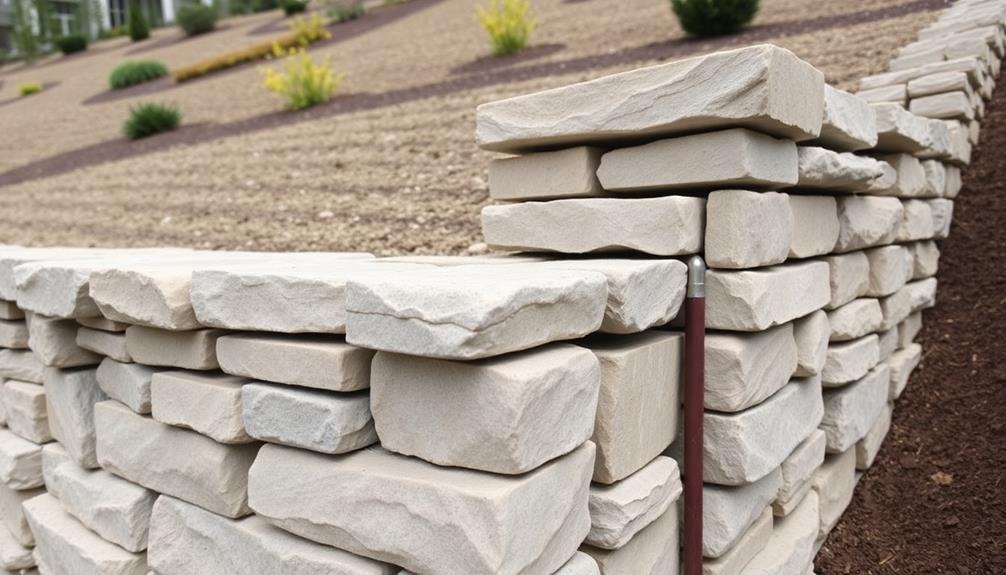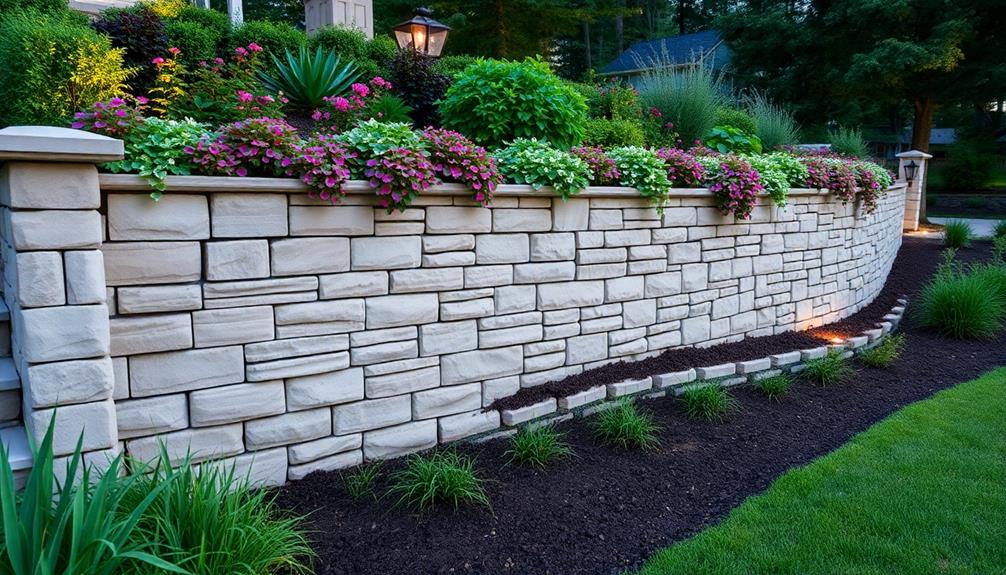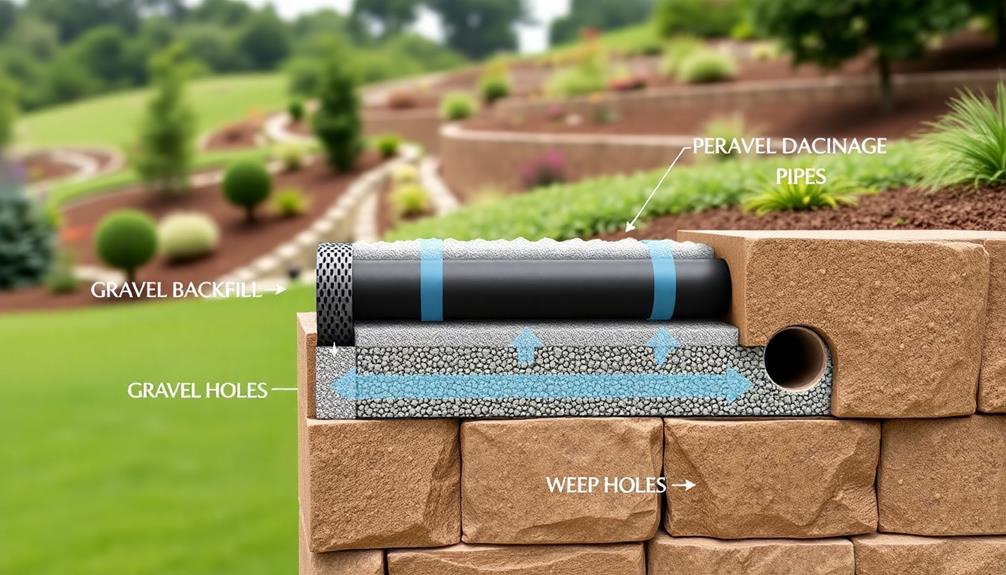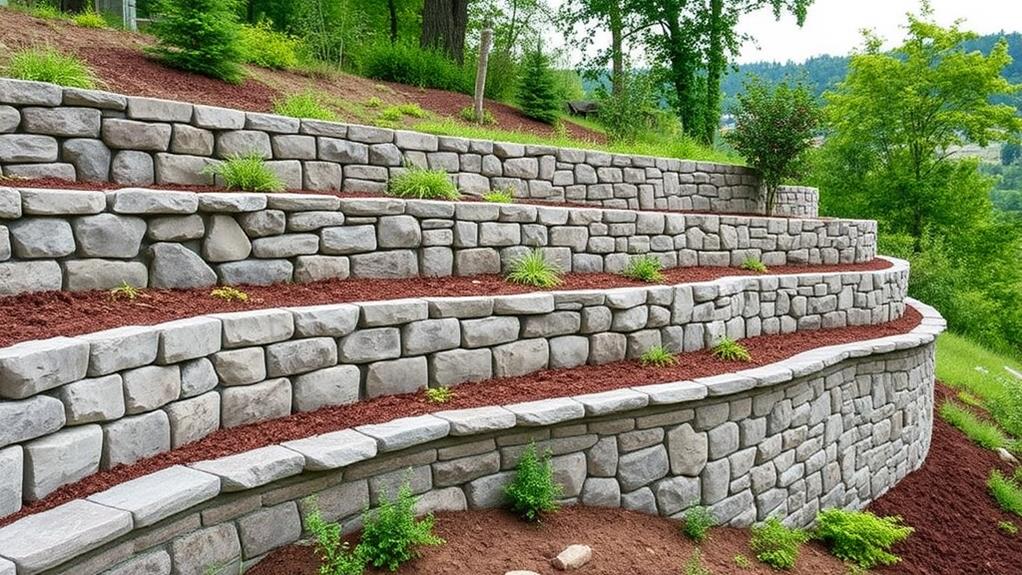Effective retaining wall design hinges on seven pivotal factors: structural integrity, load-bearing capacity calculation, material selection, drainage system integration, soil reinforcement techniques, aesthetic considerations, and proper construction methods. Engineers must carefully assess soil conditions, wall height, and potential loads to guarantee stability against overturning, sliding, and bearing capacity failure. Selecting appropriate materials that balance durability, cost-effectiveness, and visual appeal is indispensable. Implementing a robust drainage system and incorporating soil reinforcement when necessary further enhances wall performance. Attention to aesthetics and adherence to construction best practices complete the design process. Understanding these elements in greater depth is essential for creating lasting, functional retaining walls.
Table of Contents
ToggleWalls Contractor Highlights
- Calculate load-bearing capacity considering soil type, wall height, and potential loads to ensure structural integrity.
- Select appropriate materials based on durability, cost-effectiveness, and aesthetic appeal while meeting local regulations.
- Integrate an effective drainage system with perforated pipes and weep holes to manage water and prevent pressure buildup.
- Implement soil reinforcement techniques like geogrid or soil nails when necessary to enhance wall stability.
- Design the wall to complement the landscape while balancing functional requirements and visual appeal.
Structural Integrity of Retaining Walls

The structural integrity of retaining walls hinges on three critical factors: load-bearing capacity calculation, material selection considerations, and drainage system integration. Accurate load-bearing capacity calculations guarantee the wall can withstand the lateral earth pressure and any additional surcharge loads, while careful material selection takes into account factors such as durability, cost-effectiveness, and aesthetic appeal.
Boulder retaining walls offer a unique combination of strength and visual appeal, with their sheer size providing an advantage as a building material. Proper drainage system integration is essential to prevent hydrostatic pressure buildup behind the wall, which can vastly impact its long-term stability and performance.
Load-Bearing Capacity Calculation
Calculating the load-bearing capacity of a retaining wall is essential for ascertaining its structural integrity and long-term stability. Engineers and designers must carefully consider various factors that influence the wall's ability to withstand the immense pressures exerted by soil, water, and other external forces. These factors include soil type, wall height, backfill material, and potential surcharge loads from nearby structures or vehicles.
To determine the load-bearing capacity, professionals employ sophisticated mathematical models and geotechnical analysis techniques. They assess the wall's resistance to overturning, sliding, and bearing capacity failure modes. Factors of safety are incorporated into these calculations to account for unforeseen circumstances and variations in soil conditions. Advanced computer software and finite element analysis tools are often utilized to simulate complex loading scenarios and optimize the wall's design.
It is pivotal for property owners and contractors to work closely with qualified engineers during this process. By accurately calculating the load-bearing capacity, we can guarantee that the retaining wall will perform its intended function safely and effectively for years to come, protecting both the property and its occupants from potential hazards associated with soil movement or structural failure.
Material Selection Considerations
Building upon the foundation of load-bearing capacity
Drainage System Integration
Integral to the structural integrity of retaining walls, proper drainage system integration plays a central role in mitigating hydrostatic pressure and preventing water-related damage. A well-designed drainage system ensures that water accumulation behind the wall is efficiently managed, greatly reducing the risk of structural failure and erosion.
To achieve ideal drainage, professionals incorporate a combination of techniques. Perforated drain pipes are typically installed at the base of the wall, allowing water to be collected and redirected away from the structure. These pipes are surrounded by a layer of gravel or crushed stone, which acts as a filter and facilitates water movement. Additionally, weep holes are strategically placed along the face of the wall to provide an exit path for any water that may accumulate.
The integration of a geotextile fabric between the backfill material and the drainage aggregate is essential for preventing soil particles from clogging the system. This fabric allows water to pass through while retaining soil, ensuring long-term effectiveness of the drainage system. By implementing these comprehensive drainage solutions, retaining wall designers can significantly enhance the longevity and stability of their structures, providing peace of mind to property owners and engineers alike.
Benefits

Retaining walls offer a multitude of benefits that extend beyond their primary function of soil retention. These structures can substantially enhance property value by creating visually appealing and functional outdoor spaces while simultaneously providing superior erosion control.
Granite Company specialists with over 20 years of experience can design and build custom retaining walls that not only serve their functional purpose but also add aesthetic value to your property. Their expertise in utilizing various materials, including limestone, boulders, and granite, guarantees a perfect fit for any landscape design.
Moreover, retaining walls maximize usable land area on sloped properties, allowing homeowners to transform previously unusable terrain into attractive, practical spaces that seamlessly integrate with the surrounding landscape.
Enhanced Property Value
How does a well-designed retaining wall contribute to property value? A meticulously planned and executed retaining wall not only serves a functional purpose but also considerably enhances the aesthetic appeal and overall worth of a property. By creating visually appealing terraces, expanding usable land, and preventing soil erosion, these structures become valuable assets that potential buyers or appraisers recognize.
A well-constructed retaining wall can increase property value through:
- Maximizing usable space by transforming steep slopes into level areas
- Enhancing curb appeal with attractive landscaping and architectural elements
- Mitigating potential drainage issues and preventing costly foundation damage
- Creating distinct outdoor living spaces for entertainment and relaxation
The integration of a thoughtfully designed retaining wall demonstrates a commitment to property maintenance and improvement. This investment signals to prospective buyers that the property has been well-cared for and may command a higher market value. Additionally, the increased functionality and aesthetic appeal provided by a retaining wall can differentiate a property from others in the neighborhood, potentially leading to faster sales and higher offers in competitive real estate markets.
Improved Erosion Control
Beyond enhancing property value, one of the primary functions of a well-designed retaining wall is its ability to considerably improve erosion control. By strategically implementing these structures, property owners can effectively mitigate soil displacement caused by wind, water, and gravity. Retaining walls serve as a robust barrier, preventing the gradual wearing away of soil particles and maintaining the integrity of landscapes on sloped terrains.
The efficacy of retaining walls in erosion control lies in their capacity to redistribute the lateral pressure exerted by soil masses. Through careful engineering and material selection, these walls can withstand substantial forces while simultaneously facilitating proper drainage. This dual functionality guarantees that excess water is channeled away from the soil, reducing its erosive potential.
Additionally, retaining walls can be designed to incorporate vegetation, further stabilizing the soil through root systems. This symbiotic relationship between the wall and plantings not only enhances erosion control but also contributes to the aesthetic appeal of the property. By investing in a well-constructed retaining wall, property owners safeguard their land against the detrimental effects of erosion, preserving both the functionality and beauty of their outdoor spaces for years to come.
Increased Usable Space
One of the most significant advantages of incorporating retaining walls into a landscape design is the potential for increased usable space. By effectively managing slopes and elevation changes, retaining walls can transform previously unusable areas into functional, attractive spaces. This expansion of usable land not only enhances property value but also provides homeowners with additional opportunities for outdoor living and landscaping.
The benefits of increased usable space through retaining wall installation include:
- Creation of level areas for patios, gardens, or play spaces
- Expansion of buildable land on sloped properties
- Improved accessibility to previously challenging terrain
- Enhanced property aesthetics through terraced landscaping
Retaining walls offer a practical solution for maximizing land use, particularly in areas with challenging topography. By strategically implementing these structures, property owners can reclaim space that was once considered unusable, effectively expanding their outdoor living areas. This newfound space can be utilized for a variety of purposes, from creating serene garden retreats to establishing functional outdoor entertainment zones. The versatility of retaining walls allows for customized solutions that not only address specific land management needs but also complement the overall landscape design.
Aesthetic Landscape Enhancement
While retaining walls excel at maximizing usable space, their benefits extend far beyond functional improvements. These structures can substantially enhance the aesthetic appeal of a landscape, transforming an ordinary yard into a visually striking outdoor environment. When designed thoughtfully, retaining walls can serve as focal points, creating visual interest and depth within the garden or property.
The versatility of materials used in retaining wall construction allows for seamless integration with existing architectural styles and natural surroundings. From rustic stone to sleek concrete, the choice of materials can complement or contrast with the landscape, depending on the desired effect. Terraced retaining walls, in particular, offer opportunities for dramatic elevation changes, creating distinct zones within the garden and providing platforms for diverse plantings. These multi-level designs can showcase a variety of flora, from cascading vines to ornamental grasses, adding texture and color to the landscape. Additionally, retaining walls can incorporate built-in seating, planters, or water features, further enhancing their aesthetic value and creating inviting outdoor spaces for gatherings and relaxation.
Drainage Considerations for Longevity

Proper drainage is a critical component of retaining wall design, directly impacting the structure's longevity and performance. Effective water management systems, including the selection of appropriate backfill materials and the incorporation of weep holes, play pivotal roles in preventing hydrostatic pressure buildup behind the wall. These drainage considerations not only protect the wall from potential failure but also contribute to the overall stability and durability of the surrounding landscape.
| Drainage Element | Function | Impact on Longevity |
|---|---|---|
| Proper Water Management | Directs water away from wall | Reduces erosion and pressure |
| Backfill Material | Allows water to flow through | Prevents water accumulation |
| Weep Holes | Provides drainage outlets | Relieves hydrostatic pressure |
| Geotextile Fabric | Filters soil particles | Prevents clogging of drainage |
| Graded Slope | Promotes surface runoff | Minimizes water retention |
Proper Water Management Systems
Effective water management is a critical aspect of retaining wall design that directly impacts the structure's longevity and stability. Proper drainage systems help alleviate hydrostatic pressure, prevent soil erosion, and mitigate potential structural damage. To guarantee ideal performance, designers must implement thorough water management solutions that address both surface and subsurface water flow.
When developing a water management system for retaining walls, consider the following key components:
- Weep holes: Strategically placed openings that allow water to drain from behind the wall
- French drains: Perforated pipes surrounded by gravel that collect and redirect groundwater
- Geotextile fabrics: Permeable materials that prevent soil particles from clogging drainage systems
- Graded backfill: Properly compacted, well-draining soil placed behind the wall to facilitate water movement
Backfill Material Selection
Selecting appropriate backfill material is an essential step in ensuring the longevity and stability of retaining walls. The choice of backfill not only affects the wall's structural integrity but also plays a pivotal role in its drainage capabilities. Proper drainage is paramount in preventing hydrostatic pressure buildup, which can lead to wall failure over time.
When choosing backfill material, it is crucial to contemplate a well-graded, granular soil that allows for efficient water movement. Experts in the field recommend using materials such as crushed stone or gravel with particles ranging from 1/4 inch to 1 1/2 inches in diameter. These materials provide excellent drainage properties while simultaneously offering sufficient compaction to support the wall.
It is imperative to avoid using clay-rich soils or organic materials as backfill, as they retain water and can lead to increased pressure on the wall structure. Additionally, incorporating a layer of geotextile fabric between the native soil and backfill material can further enhance drainage and prevent soil migration. By carefully selecting and properly installing the appropriate backfill material, you can vastly extend the lifespan of your retaining wall and minimize the risk of future structural issues.
Weep Holes Importance
A retaining wall's longevity hinges greatly on its ability to manage water effectively, making weep holes an indispensable component of the structure. These small drainage openings, strategically placed along the wall's base, serve to alleviate hydrostatic pressure buildup behind the wall. By facilitating proper water drainage, weep holes mitigate the risk of structural damage and soil erosion, safeguarding the wall's stability and prolonging its lifespan.
When incorporating weep holes into your retaining wall design, consider the following critical factors:
- Spacing: Typically, weep holes should be placed at intervals of 4 to 6 feet along the wall's length.
- Size: The diameter of weep holes generally ranges from 2 to 4 inches, depending on the wall's height and anticipated water volume.
- Filtration: Utilize geotextile fabric or gravel filters to prevent soil particles from clogging the weep holes.
- Slope: Guarantee a slight downward angle for the weep holes to promote efficient water drainage away from the wall's foundation.
Walls Contractor FAQ
What Materials Are Best for Building Retaining Walls in Coastal Areas?
For coastal retaining walls, corrosion-resistant materials are essential. Consider using marine-grade concrete, stainless steel reinforcements, or treated timber. These choices will withstand saltwater exposure and harsh conditions, ensuring longevity and stability for our coastal structures.
How Often Should Retaining Walls Be Inspected for Potential Issues?
Retaining walls should be inspected annually for structural integrity and potential issues. For coastal areas, more frequent inspections—every six months—are recommended due to increased exposure to moisture and erosion. Regular monitoring guarantees the wall's longevity and community safety.
Can Retaining Walls Be Designed to Incorporate Seating or Planters?
Retaining walls can be creatively designed to include built-in seating or integrated planters. This approach not only enhances functionality but also creates inviting spaces for our community to gather and enjoy the outdoors together.
Are There Eco-Friendly Options for Retaining Wall Construction?
Eco-friendly retaining wall options include recycled materials, permeable designs, and native plant integration. These sustainable choices not only benefit the environment but also create a sense of harmony with nature in our outdoor spaces.
What Permits Are Typically Required for Building a Retaining Wall?
Permit requirements for retaining walls vary by location, but typically include building permits for walls over a certain height. Check with your local building department to ascertain compliance with zoning laws, safety regulations, and environmental considerations.







